History
Japanese Internment
Japanese internment refers to the forced relocation and incarceration of Japanese Americans during World War II. Following the attack on Pearl Harbor, the US government implemented Executive Order 9066, which authorized the removal of Japanese Americans from the West Coast and their placement in internment camps. This policy resulted in the violation of the civil rights of thousands of Japanese Americans.
Written by Perlego with AI-assistance
Related key terms
12 Key excerpts on "Japanese Internment"
- eBook - ePub
Transitional Justice in Established Democracies
A Political Theory
- S. Winter(Author)
- 2014(Publication Date)
- Palgrave Macmillan(Publisher)
At the time of their removal from the west coast of the United States, Japanese Americans were concentrated in rural enclaves and mainly employed in agriculture and fishing. 2 Exclusion and removal took entire communities. Although they were better off than most Japanese Americans materially, the Ichihashis bore their own burdens. At 1067 days, their detention was longer than the average 900. Their marriage suffered and Yamoto Ichihashi became estranged from their only son, Woodrow. 3 ‘Internment’ is the term conventionally used to describe the forcible removal of more than 120 000 Japanese Americans from their homes and workplaces, their exclusion from the West Coast, and detention in temporary camps. The term is misleading. 4 Usually ‘internment’ describes the detention of enemy aliens or material during wartime. But two-thirds of the detainees were American citizens. Irrespective of citizenry, Japanese Americans were denied basic civil rights of association, privacy, movement, occupation, and due process. They lost real and chattel property. Caught between the Anglo Saxon civilizational regime and wartime security concerns, Japanese Americans were treated as enemies of the state. The wrongful exclusion, removal, and detention of Japanese Americans would lead to one of the best known state redress programmes of modern times, the Civil Liberties Act. 5 The Civil Liberties Act set standards for later programmes. 6 It is also one of the most amenable to a corrective justice understanding. The chapter begins by describing both the relevant wrongdoing and salient elements of corrective justice theory. The chapter then uses that theoretical framework to analyze Japanese American redress. The underlying argument is (as Chapter 5 indicated) that because state wrongdoing burdens its legitimacy, providing corrective justice relieves the state - Angela K. Smith, Sandra Barkhof(Authors)
- 2018(Publication Date)
- Routledge(Publisher)
3 The education included setting aside funds to preserve the camps, develop interpretive centres, and support community memorials that would share the experience of Japanese Americans during the internment. To leave the internment as a hidden part of America’s past or as a justified reaction to the threat facing the West Coast of the United States would allow the potential violation of civil rights to be extended to a new ethnic or religious group. Although the ethnic space of Japanese Americans in World War Two is the primary focus of this essay, the memories of internment are increasingly linked to the potential repetition of discrimination of other groups during times of conflict. “Never Forget” has become the mantra for Japanese Americans in their commemoration of their incarceration and in news stories comparing contemporary treatment of Muslim Americans and Syrian refugees with the World War Two experience of Japanese Americans. For example, the Densho Blog of November 15, 2015, opines,We’re struck by the sad familiarity of the language being used to vilify Syrians … “our own history has taught us that during times of crisis it is all the more important to maintain our humanity and compassion. If we lose that, the forces we purport to fight have truly won.”4This chapter explores the firsthand report of the civilian experience of World War Two for artist Roger Shimomura who, with his family, spent 1942–1945 interned in a US concentration camp in Minidoka, Idaho. As a young child at the time, Shimomura’s memories are tied up with those passed on by his parents and grandparents, and with his experiences after internment. His art tells the story of Japanese-American internment as a narrative of individual and national trauma that still continues 75 years after President Roosevelt signed Executive Order 9066.Shimomura is a third-generation Japanese American whose paintings and lithographs (part of the permanent collection of more than 90 museums) confront the sociopolitical and psychological consequences of war and racial prejudice that he sees still present for Asian Americans. Like literary texts, art creates cultural memory from the experiences recreated by the artist. This essay reviews Shimomura’s series Yellow No Same, Memories of Childhood, American Knockoff, and An American Diary- eBook - ePub
- Linda L. Ivey, Kevin W. Kaatz(Authors)
- 2020(Publication Date)
- ABC-CLIO(Publisher)
The Civil Liberties Act of 1988 and the success of the redress movement seemed to open the floodgates for historians to get more and more access to documents and first-person narratives, largely attributed to the lifting of a “veil of shame” among survivors that came with reparations. The internment-as-abrogation of civil rights narrative has since deservedly been given significant attention, and both primary literature and secondary analysis address the loss of freedom, property, and dignity in what was an essentially racist act. While paying reverence to this narrative of injustice, historians in the past two decades have begun to carve out new areas of inquiry concerning the motivations, mechanisms, and long-term meanings of the internment.Among these new narratives used to analyze the complexity of this federal action are those that have sought to understand the action of internment in the United States as part of a global response during wartime toward enemy nationals within their boundaries. Others have focused on the role of the executive branch in order to understand why Roosevelt may have supported—or at least tolerated—the decision to evacuate Japanese and Japanese Americans. Recently, studies have emerged concerning allies outside of the camps, including radicals, African Americans, Jews, and white liberals. Hayashi’s own work adeptly addresses both the experience of the internees and the complexity of the internment management. He looks closely at the words of the military and government leaders to examine how they worked within the context of military necessity and caution. Further, he wrestles with the actions and motivations of the camp administrators and social scientists who attempted to facilitate the functioning of the camps (and thus the success of the internment) while supporting the internees.13In other recent books, scholars have likewise brought the internment episode out of its historical bubble, exploring the history within a broader context. Mae M. Ngai’s 2014 Impossible Subjects: Illegal Aliens and the Making of Modern America examines the production of “alien citizens,” including Asian Americans, who are “born in the United States with formal US citizenship but who remained alien in the eyes of the nation.”14 - Charles J. McClain, Charles McClain(Authors)
- 2013(Publication Date)
- Routledge(Publisher)
JUSTICE, WAR, AND THE JAPANESE-AMERICAN EVACUATION AND INTERNMENT
Book Review of—JUSTICE AT WAR: THE STORY OF THE JAPANESE AMERICAN INTERNMENT CASESDOI: 10.4324/9780203054499-7By Peter Irons. New York: Oxford University Press, 1983. Pp. xiii, 407. $18.95.Reviewed by Arval A. Morris** Professor of Law, University of Washington.With all the advantages of hindsight, the shameful episode that saw the militarily ordered exclusion and internment of over 112,000 Japanese Americans during World War II without declaration of martial law looms as one of the greatest mass deprivations of civil liberties by the American government since slavery.1 This harsh, vast, and discriminatory program of uprooting and imprisoning concededly loyal Americans was initiated by an Army general and avidly ordered and supervised by civilian heads of the War Department, defended by the Justice Department, authorized by President Roosevelt, endorsed by Congress, approved by the Supreme Court, and, sadly, supported by the people. The additional sad fact is that except for General DeWitt, every person important to producing this shameful affair was a lawyer. Today, the wartime episode of the Japanese Americans remains an evil blotch upon our national legal conscience and our law, just as it was yesterday and surely will continue to be until the Japanese-American cases2 are repudiated, overruled, and completely excised from our law.1. This shameful episode embodied “one of the most sweeping and complete deprivations of constitutional rights in the history of this nation.” Korematsu v. United States, 323 U.S. 214, 235 (1944) (Murphy, J., dissenting). Thirty-six years later, Congress, by the Commission On Wartime Relocation and Internment Act, Pub. L. No. 96-317, § 2, 94 Stat. 964 (1980), created a commission composed of former members of Congress, the Supreme Court, the Cabinet, and distinguished private citizens. The Commission held hearings in cities across the United States, reviewed documents and made findings and conclusions that were unanimous. In general, the Commission found that“[t]he broad historical causes which shaped these decisions [regarding exclusion and detention] were race prejudice, war hysteria, and a failure of political leadership; that there was substantial credible evidence, known at the time, from governmental agencies indicating that the claimed ground of military necessity was defective and did not warrant the exclusion and detention of ethnic Japanese,” and that as a result, “[a] grave injustice was done to American citizens and resident aliens of Japanese ancestry who, without individual review or any probative evidence against them- eBook - ePub
Studies in United States Culture
Testimony and Redress in U.S. Prison Camps since World War II
- A. Naomi Paik(Author)
- 2016(Publication Date)
- The University of North Carolina Press(Publisher)
Part I
Japanese Internment camps United States (various locations) May 1942–March 1946On 14 February 1942, two months after Japanese forces attacked Pearl Harbor and the United States officially entered the Second World War, President Franklin D. Roosevelt signed Executive Order 9066, authorizing the mass evacuation and imprisonment of all ethnic Japanese persons living on the West Coast, including 80,000 U.S. citizens. The Wartime Civilian Control Administration (WCCA), the federal agency hurriedly created to manage the evacuation, gave these 120,000 citizens and residents as little as two weeks to settle their affairs. Properties were sold short; businesses shuttered. The WCCA then transported this suspect group of people—now called “internees”—en masse to nearby assembly centers, some of them in whitewashed horseracing or fairground facilities. In these cases, families took the place of horses. From assembly centers, internees were then removed to one of ten internment camps located in the deserts of the West or in the swamps of Arkansas.The War Relocation Authority (WRA), another civilian government agency established to administer internment, built the camps within a few months. The camps ranged in size, holding anywhere from 7,000 to nearly 19,000 inmates. They were organized into housing blocks that each contained rows of barracks, a mess hall, a communal hall, laundry facilities, and men’s and women’s bathrooms. The camps also contained administrative buildings and housing for soldiers, as well as buildings that served as hospitals, schools, religious sites, canteens, and post offices. The barracks each measured about 120 feet by 20 feet, and were divided to house up to six families. Each apartment contained a single light fixture, a stove for heating, and a cot for each resident. Hastily constructed out of cheap materials and covered with tar paper, this housing offered little privacy or shelter from the extreme weather. The windows and doors often did not fit their frames; large gaps grew between the planks of wood as time wore on. - eBook - ePub
When Sorry Isn't Enough
The Controversy Over Apologies and Reparations for Human Injustice
- Roy L. Brooks(Author)
- 1999(Publication Date)
- NYU Press(Publisher)
12 Peru pushed for additional Japanese deportations, but the United States could not commit the shipping and did not want to augment the hundreds of Japanese internees awaiting repatriation. The State Department also decided not to repatriate Axis nationals against their will, realizing that many internees might not want to return to a devastated country. Thus deportation proceedings lagged and the INS internment camps became overcrowded.Internees at INS camps in Crystal City, Kennedy and Seagoville, Texas, and Missoula, Montana, had two main concerns: having their families join them in the United States and repatriation to Japan. Living conditions at the camps were not unlike those in the war relocation centers. Confinement’s bad effects were evident: lack of privacy, family breakdown, listlessness and uncertainty about the future. To safeguard the internees from unhealthy conditions, the camps were inspected routinely by Spain, the International Red Cross, the War Prisoners Aid of the YMCA and the YWCA, the American Friends Service Committee, and the National Catholic Welfare Conference. At the end of the war, approximately 1,400 Latin American Japanese, mostly from Peru, were interned in the United States, awaiting a decision on their destiny. Some wished to return to Latin America, others to Japan. To most it was a choice of the lesser of two evils: they had lost everything in Latin America, but Japan, which they had left to pursue greater economic opportunity, was devastated by the war. A number wanted to remain in the United States and begin anew.In December 1945, approximately 800 Peruvian Japanese were voluntarily deported to Japan,13 but in general the internment ended very slowly and tortuously. The United States sought to return internees, who were not classified as dangerous and who refused deportation to Axis countries, to their points of origin in Latin America. . . .14. . . [T]he internees used litigation to block deportation to Axis states. Some German internees filed habeas corpus petitions challenging their detention by the United States, claiming that they were not alien enemies as defined by the Alien Enemy Act of 1798, because they were not natives or citizens of an enemy country. In January 1946, this effort failed when a federal district court ruled that the Latin America internees were “alien enemies” who could legally be detained.15 After this decision, 513 Japanese (over ninety percent from Peru), 897 Germans and 37 Italians from Latin America in United States internment camps were granted hearings pending deportation to Axis countries.16 The hearings were a formality leading inevitably to deportation to Axis countries, although most of the remaining Latin American Japanese wished to return to Peru. Voluntary repatriation continued into 1946, with at least 130 Peruvian Japanese returning to Japan by June.17 - eBook - ePub
Father, Son, and Constitution
How Justice Tom Clark and Attorney General Ramsey Clark Shaped American Democracy
- Alexander Wohl(Author)
- 2013(Publication Date)
- University Press of Kansas(Publisher)
3The Japanese InternmentThe Constitution has not greatly bothered any wartime president.Attorney General Francis BiddleLong before the Japanese bombed Pearl Harbor and the United States declared war on Japan and ordered the unprecedented evacuation and internment of its Japanese American citizens, Japanese immigrants to the United States faced significant prejudice and bigotry. What was different in the aftermath of Pearl Harbor was the official nature of that discrimination and how the government made claims of national security to target a particular ethnic group in support of its actions. It was, explained one contemporaneous study of the period, “an act without precedent in American history . . . the first time that the United States government condemned a large group of people to barbed-wire enclosures. It was the first event in which danger to the nation’s welfare was determined by group characteristics rather than by individual guilt. It was the first program in which race alone determined whether an American would remain free or become incarcerated.”1 It would also be Tom Clark’s first significant role in which he applied the power of the government to restrict the actions of individuals.The first Japanese immigrants arrived on the mainland United States in California in 1869, just a year after Japanese immigrants had come to Hawaii. By the end of the century the Japanese population in California had grown to more than 10,000, with more than 85,000 Japanese immigrants nationwide. The growth was due in part to an increased demand for Japanese laborers, which had swelled because of restrictions on Chinese immigration. These restrictions were further expanded by the Chinese Exclusion Act of 1902, which prohibited all immigration from China. The new century brought even greater numbers of Japanese immigrants to the shores of California; by 1940, the population had reached nearly 94,000, about a third of the total number of Japanese in the United States. The total U.S. population in 1940 was just over 132 million.2 - eBook - ePub
Western Histories
An Unknown Transpacific History of Japanese-Mexican Relations
- Yu Tokunaga(Author)
- 2022(Publication Date)
- University of California Press(Publisher)
Food security is often an overlooked subject in the study of Japanese Internment, as its legal and military aspects tend to be foregrounded. By looking at the Japanese Internment from an agricultural perspective, we can deepen our historical understanding of this tragedy through the lens of interethnic relations, which takes into account, for example, the resistance of white leaders such as Olson to full-scale internment and the substitution of Mexican workers provided to replace Japanese agricultural labor. Consideration of these understudied realities may shift the narrative of Japanese Internment from an almost exclusive focus on the ethnic Japanese population to inclusion of non-Japanese populations who also experienced the impact of Japanese Internment. Seen from this perspective, Japanese Internment is not simply an ethnic Japanese experience but rather an integral part of the racial and economic history of California, a region characterized by a uniquely diverse population and economy.JAPANESE AGRICULTURE IN WARTIME CALIFORNIA
After Japan’s surprise attack on Pearl Harbor on December 7, 1941, the US government declared war on Japan, and thus Japanese immigrants became enemy aliens in the United States. After ten weeks, President Franklin Delano Roosevelt signed Executive Order 9066 providing a legal basis for the mass removal of Japanese immigrants (Issei) and Americans of Japanese ancestry (US-born citizens) from the Pacific Coast of the mainland United States. As far as agriculture was concerned, US agricultural officials faced two contradictory tasks created by the Pearl Harbor attack: keeping Japanese farms operational for the Food-for-Freedom program while also removing the Japanese from their farms. Eventually, the War Department and USDA reached a compromise by keeping Japanese farms functioning yet without the Japanese. However, before putting this compromise into action, local USDA officials in California had to handle a messy situation caused by the Treasury Department’s freezing of Japanese bank accounts immediately following the Pearl Harbor attack.5 Around that time, Japanese farmers produced from 35 to 50 percent of the vegetables grown in California, and California’s vegetable harvest constituted between one- to two-thirds of the country’s vegetable production. About 5,000 ethnic Japanese farmers operated 175,000 acres of California farmland, constituting more than half of the total California farmland devoted to vegetables.6 In Los Angeles County, the number of Japanese-operated farms increased from 531 in 1910 to 1,523 in 1940 operating 28,670 acres.7 In 1940, the ethnic Japanese population in Los Angeles County was 36,866, representing 39 percent of the Japanese population in California and, more importantly, 29 percent of the entire Japanese population in the mainland United States. In Los Angeles County, about 28 percent of the total 17,005 employed ethnic Japanese were engaged in agriculture and about 90 percent of Japanese farmers were tenants. Ethnic Japanese farmers dominated the county’s production of at least seventeen crops, including celery, peas, spinach, beets, broccoli, radishes, peppers, snap beans, strawberries, cauliflower, and lettuce.8 - eBook - ePub
Closing the Golden Door
Asian Migration and the Hidden History of Exclusion at Ellis Island
- Anna Pegler-Gordon(Author)
- 2021(Publication Date)
- The University of North Carolina Press(Publisher)
Internment had a profound and lasting impact on New York City. Japanese New Yorkers may have faced less discrimination and, as a result, were more likely to be intermarried or residentially integrated than Japanese living in the western United States. Nevertheless, they were still raided, interned, and treated more harshly than German or Italian nationals. They were not subject to wholesale forced removal and incarceration, but their loyalties were strained and their families were torn apart. Ellis Island officials attempted to understand the complex loyalties of Japanese civilians, but their efforts often resulted in arbitrary rulings. Almost half of all Japanese New Yorkers were repatriated to Japan. Yet, the Japanese population of the East Coast increased, largely because of resettlement and the uprooting of long-established Japanese communities in the West.World War II enemy alien internment affected every Japanese person in New York. Although historians have increasingly paid attention to enemy alien internment, the importance of New York and the role of Ellis Island have been largely overlooked. The iconic image of the island as the United States’ largest immigration station during times of peak European immigration from the 1890s through the 1920s has obscured its equally important role as an alien detention center.Wartime confinement was not only built upon existing practices of exclusion, detention, and deportation but also contributed to their expansion in the postwar period as parole procedures developed to monitor enemy aliens were extended to all aliens. In 1946, more than 116,000 unauthorized immigrants were removed from the United States, almost 50 percent more than the previous year. The INS proudly noted that “never in the recorded history of the Service have so many illegal entrants been expelled.” Even though the INS had expanded its detention facilities during the war and accelerated deportation proceedings as the war ended, this massive expansion of deportation was costly and time-consuming. In order to address these concerns, the INS extended “the basic principles of the parole system, as applied to alien enemies, to aliens under immigration proceedings generally.” Immigration officials acknowledged that “prior to the administration by this Service of the alien enemy parole program there was no formalized uniform system in effect on parole supervision over aliens under deportation proceedings.”152 - Jade Tsui-yu Lee(Author)
- 2020(Publication Date)
- Palgrave Pivot(Publisher)
The incarceration became an indelible trace for the internees. As if in an image of “still water runs deep,” they look taciturn and reticent, but underneath is the collective evidence of repressed anguish and melancholy.One should keep in mind that even during wartime, public opinion toward the Japanese forced internment was contentious and divided. A 2014 Newsweek article followed Otsuka’s 2012 article on wartime internment, documenting the magazine’s reporting of the pros and cons of the experience. The opponents of the policy included those who thought it would violate American citizens’ rights, and those who believed that the policy would lead to a racial war, which could have been disadvantageous for the US war campaign overseas. Despite these opposing remarks, the policy was supported by the majority of general public (Verger). The article prophesizes what would take place after the relocation Order: “And yet these arguments were mooted, because the relocation happened anyway. As for the consequences? ‘At best it will leave wounds,’ … At worst, the cost could be ‘the permanent alienation of a group of citizens’ who might have been useful to the U.S. in the war” (Verger).Otsuka has captured subtle and paradoxical sentiments in her novel. It is understandable that people in California, according to the Newsweek article, “were more anxious than ever to get rid of their aliens after rumors that signal lights were seen before submarine attacks” (Verger). In the novel, Otsuka depicts a shop clerk averting eye contact and neighbors, eluding avoidance:… the Gilroys and the Myers, the Leahys, the Wongs, the two elderly Miss O’Grady’s … They had all seen us leave, at the beginning of the war, had peered out through their curtains as we walked down the street with our enormous overstuffed suitcases. But none of them came out, that morning, to wish us goodbye, or good luck, or ask us where it was we were going (we didn’t know). None of them waved.They’re afraid, our mother had said. Keep on walking. Hold your head up. Whatever you do, don’t look back.Now when we ran into these same people on the street they turned away and pretended not to see us. Or they nodded in passing and said “Gorgeous day,” as though we had not been away at all. (Otsuka Emperor- eBook - ePub
- Tanya Sheehan, Tanya Sheehan(Authors)
- 2018(Publication Date)
- Routledge(Publisher)
Part I(Im)mobilityMap 1 Major sites in chapters 2 – 4 .Passage contains an image
Photography and Japanese Americans from incarceration to resettlement2Back to AmericaJasmine AlinderDescent has taken priority over citizenship. American citizens are being held prisoners by their own government. They are told that to be prisoners is the patriotic thing to do…. But this is America; these things happening today are not American…. Fascism must be extinguished here. Just a rambling thought in remembrance of the 4th. Incarceration of liberty.– Gordon K. Hirabayashi, diary entry from King County Jail, July 4, 19421The history of Japanese American incarceration and its aftermath cannot be told as a simple story of a revolving door: the United States government forced Japanese Americans into concentration camps and later permitted them to return home. That linear narrative obscures the experiences of most Japanese Americans who endured multiple wartime migrations including two or more different sites of confinement and, once cleared for leave, the possibility of multiple moves within the US as well as repatriation to Japan. As the camps were dismantled, the government initially forbade Japanese Americans from returning to their West Coast homes and instead created a network of resettlement offices to encourage their dispersal throughout the Midwest and East Coast. Writing in 1946, one US official wrote that Japanese Americans’ “return to the main stream [sic ] of life in American communities can best be stated in terms of motion.”2 That motion, however, had been highly restricted and involved the potential of multiple paths of surveilled migration.Throughout the process of incarceration and its aftermath, photography was a crucial medium and site of struggle. Photographs became tools to persuade Americans outside the concentration camps that Japanese Americans could be rewoven into the body politic and to assure Japanese Americans that better lives awaited them on the outside. Both the War Relocation Authority (WRA), the civilian agency created to manage the incarceration and resettlement, and independent publishers made their pitch for the integration of Japanese Americans into American communities through photographically illustrated booklets and pamphlets. The images in these modest publications argued that the terms Japanese and American were not mutually exclusive categories. This chapter considers how one such booklet titled Outcasts! The Story of America’s Treatment of Her Japanese-American Minority - eBook - ePub
The Safety of the Kingdom
Government Responses to Subversive Threats
- J. Michael Martinez(Author)
- 2015(Publication Date)
- Carrel Books(Publisher)
222Through all the fits and starts, the vacillation and second-guessing, the administration had reached a decision. Military necessity supposedly required that tens of thousands of persons of Japanese ancestry, many of whom were children, must be rounded up and herded into camps to ensure the safety and security of the US homeland. If their constitutional rights were violated as a direct consequence of this action, so be it. Security trumps liberty in times of crisis.223Executive Action and Its ConsequencesOn February 19, 1942, the president issued Executive Order 9066 identifying “exclusion zones” and “military areas” “from which any or all persons may be excluded.” Although the executive order did not specifically mention a particular nationality, it became the basis for a subsequent decision to exclude persons of Japanese ancestry from the West Coast, essentially all of California and much of Oregon, Washington, and Arizona. Roosevelt eventually issued Presidential Proclamations 2525, 2526, and 2527 designating Japanese, German, and Italian nationals as enemy aliens.224Historians are divided on the reasons why the president ultimately signed the executive order. Perhaps Americans’ deep, long-simmering antipathy toward Asians was a factor. The administration might have feared an imminent attack on the mainland, and the possibility that some Japanese living in the country would provide intelligence to the assailants. Given the increasing popularity of relocating the Japanese, Roosevelt may have allowed political calculations to take precedence over constitutional rights. As is often the case when a traumatic event occurs, Americans reacted viscerally. They sought a clear explanation and a convenient scapegoat for what happened. Only distance and hindsight allow for a dispassionate assessment of what happened, and why.225
Index pages curate the most relevant extracts from our library of academic textbooks. They’ve been created using an in-house natural language model (NLM), each adding context and meaning to key research topics.











